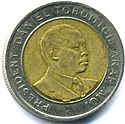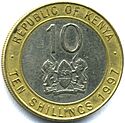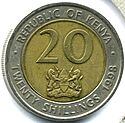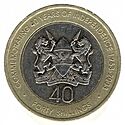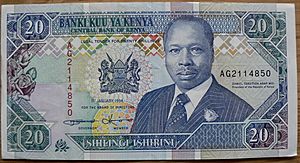Kenyan shilling facts for kids
Quick facts for kids Kenyan shilling |
|
|---|---|
| ISO 4217 Code | KES |
| User(s) | Kenya |
| Inflation | 4.3% |
| Source | Kenya National Bureau of Statistics, as of July 2024. |
| Subunit | |
| 1⁄100 | cent |
| Coins | 1/=, 5/=, 10/=, 20/= |
| Banknotes | 50/=, 100/=, 200/=, 500/=, 1,000/= |
The shilling (called shilingi in Swahili) is the official money used in Kenya. Its special code is KES, and you might see it shortened as KSh. One shilling is made up of 100 smaller units called cents. The Central Bank of Kenya is in charge of printing and making all the Kenyan money.
Contents
How Money is Written
When you see prices in Kenya, they are often written in a special way. It looks like "x/y". Here, 'x' means the amount in shillings, and 'y' means the amount in cents.
- If there are no shillings, it might be written as "-/50" for 50 cents.
- If there are no cents, it might be "100/-" or "100/=" for 100 shillings.
Sometimes, the letters KSh are put in front to make it clear it's Kenyan money. For example, KSh 10 million. This way of writing money is similar to how British pounds were written a long time ago.
History of Kenyan Money
The Kenyan shilling started being used in 1966. It took the place of the East African shilling at the same value.
Kenyan Coins Through Time
| 10 cents (1980). | |
|---|---|
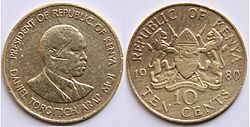 |
|
| Front: Picture of Daniel arap Moi, who was President of Kenya. | Back: The coin's value, the year it was made, Kenya's national symbol, and the country's name. |
The first Kenyan coins were made in 1966. They came in values like 5, 10, 25, and 50 cents, and 1 and 2 shillings. Over the years, some values were stopped, and new ones were added. For example, 5 shilling coins came out in 1973, 10 shillings in 1994, and 20 shillings in 1998.
From 1967 to 1978, the coins showed Jomo Kenyatta, Kenya's first president. Then, from 1980 to 2005, they featured Daniel arap Moi. In 2005, new coins were made, and Kenyatta's picture returned. These new coins included 50 cents and 1 shilling made of stainless steel. There were also special coins made of two different metals for 5, 10, and 20 shillings. In 2003, a special 40 shilling coin was made to celebrate 40 years of Kenyan independence. This coin had a picture of the president at the time, Mwai Kibaki.
- Coins of Kenya, 1980 and 2003
In 2010, a new law was made. It said that Kenyan money should show symbols of Kenya, not pictures of individuals. Because of this, a brand new set of coins was released on December 11, 2018. These coins come in values of 1, 5, 10, and 20 shillings. The front of these coins shows the national Coat of arms of Kenya. The back features famous African animals. These new coins were also designed to be easier for people with poor eyesight to recognize.
| Coins of the Kenyan shilling (2018 issues) | |||||||
|---|---|---|---|---|---|---|---|
| Image | Value | Technical details | What they look like | ||||
| Diameter | Weight | Material | Edge | Front side | Back side | ||
| 1/= | 23.9 mm | 5.5 grams | Nickel-plated steel | Smooth and ridged sections | Coat of arms of Kenya; "Republic of Kenya" in English and Swahili | Giraffe; value in English and Swahili | |
| 5/= | 19.5 mm | 3.75 grams | Two metals (Brass-plated steel center with Nickel-plated steel outer ring) | Ridged | Coat of arms of Kenya; "Republic of Kenya" in English and Swahili | Rhinoceros; value in English and Swahili | |
| 10/= | 23 mm | 5 grams | Two metals (Nickel-plated steel center with Brass-plated steel outer ring) | Ridged | Coat of arms of Kenya; "Republic of Kenya" in English and Swahili | Lion; value in English and Swahili | |
| 20/= | 26 mm | 9 grams | Two metals (Brass-plated steel center with Nickel-plated steel outer ring) | Smooth and ridged sections | Coat of arms of Kenya; "Republic of Kenya" in English and Swahili | Elephant; value in English and Swahili | |
Why Some Coins Are Not Used Much
Even though the Central Bank of Kenya says all coins are still valid, some people, especially in rural areas, don't like to use 50 cent and 1 shilling coins. This is because they feel these small coins don't have much value anymore.
Kenyan Banknotes Through Time
On September 14, 1966, the Kenyan shilling banknotes replaced the East African shilling notes. The first notes were for 5, 10, 20, 50, and 100 shillings. All these notes showed Jomo Kenyatta on the front and different economic activities on the back.
- Over time, some banknote values were replaced by coins. The 5 shilling note became a coin in 1985. The 10 and 20 shilling notes became coins in 1994 and 1998.
- New, higher value notes were also introduced: 200 shillings in 1986, 500 shillings in 1988, and 1,000 shillings in 1994.
Just like with the coins, the banknotes first showed Kenyatta. Then, in 1980, Daniel arap Moi's picture appeared on the notes. After Mwai Kibaki became president in 2003, some older notes with Kenyatta's picture were used again for a short time. Then, a new series of notes was printed with Kenyatta's picture for 50, 100, 200, 500, and 1,000 shillings. A special 200 shilling note was made in 2003 to celebrate 40 years of Kenya's independence. These banknotes are printed in Nairobi by a company called De La Rue.
New Banknotes for a New Era (2019)
On May 31, 2019, the Central Bank of Kenya released a brand new set of banknotes. These notes do not have pictures of any specific people, following the 2010 Constitution of Kenya. At the same time, all older 1,000 shilling notes were taken out of use by October 1, 2019.
All the new banknotes have a picture of the Kenyatta International Convention Centre on the front. The back of the notes shows different parts of Kenya's rich culture and nature:
- 50 shillings: "Green Energy" (like wind and solar power) and a buffalo.
- 100 shillings: "Agriculture" (farming and livestock) and a leopard.
- 200 shillings: "Social Services" (health, education, sports) and a rhinoceros.
- 500 shillings: "Tourism" (wildlife) and a lion.
- 1,000 shillings: "Governance" (Parliament building) and an elephant.
Each of the five notes also features one of Africa's "big five" animals.
Latest Banknotes (2024 Series)
The Central Bank of Kenya started releasing updated banknotes in 2024, beginning with the 1,000 shilling note. This new note looks very similar to the 2019 series but has some important updates. These include new signatures from the current Governor of the Central Bank, Kamau Thugge, and a new board member. It also shows the year it was printed and has better security features to stop fake money.
The new 1,000 shilling note will be used alongside the older ones. There was some discussion online when it was announced that a German company, Giesecke+Devrient, would print these new notes for five years.
| Banknotes of the Kenyan shilling (1996 "Arap Moi" issue) | ||||
|---|---|---|---|---|
| Image | Value | Front side | Back side | Special mark |
| 20/= | President Daniel arap Moi; Coat of arms of Kenya | Baton; Moi International sports complex, Nairobi, jogger | Lion's head | |
| 50/= | President Daniel Toroitich arap Moi; Coat of arms of Kenya | Caravan; Elephant tusks monument in Moi Avenue (formerly Kilindini Road), Mombasa | Lion's head | |
| 100/= | President Daniel Toroitich arap Moi; Coat of arms of Kenya | Monument to the 25th anniversary of independence, Nairobi | Lion's head | |
| 200/= | President Daniel Toroitich arap Moi; Coat of arms of Kenya | Unity monument, Nairobi | Lion's head | |
| 500/= | President Daniel Toroitich arap Moi; Coat of arms of Kenya | Parliament building, Nairobi | Lion's head | |
| 1,000/= | President Daniel Toroitich arap Moi; Coat of arms of Kenya | Elephants | Lion's head | |
| Banknotes of the Kenyan shilling (2004 "Jomo Kenyatta" issue (to be withdrawn from circulation)) | ||||
|---|---|---|---|---|
| Image | Value | Front side | Back side | Special mark |
 |
50/= | President Jomo Kenyatta; Coat of arms of Kenya | Caravan; Elephant tusks monument in Moi Avenue (formerly Kilindini Road), Mombasa | Lion's head and electrotype 50 |
 |
100/= | President Jomo Kenyatta; Coat of arms of Kenya | Kenyatta statue; tower | Lion's head and electrotype 100 |
| 200/= | President Jomo Kenyatta; Coat of arms of Kenya | Cotton harvest | Lion's head and electrotype 200 | |
| 500/= | President Jomo Kenyatta; Coat of arms of Kenya | Parliament building, Nairobi | Lion's head and electrotype 500 | |
 |
1,000/= | President Jomo Kenyatta; Coat of arms of Kenya | Elephants | Lion's head and electrotype 1000 |
Exchange Rate
You can easily find out how much the Kenyan shilling is worth compared to other currencies using services like the one below:
| Current KES exchange rates | |
|---|---|
| From Google Finance: | AUD CAD CHF EUR GBP HKD JPY USD |
| From Yahoo! Finance: | AUD CAD CHF EUR GBP HKD JPY USD |
| From XE.com: | AUD CAD CHF EUR GBP HKD JPY USD |
| From OANDA: | AUD CAD CHF EUR GBP HKD JPY USD |
| From fxtop.com: | AUD CAD CHF EUR GBP HKD JPY USD |
See also
- Economy of Kenya
- Ugandan shilling
- Tanzanian shilling
- Shilingi (disambiguation)


